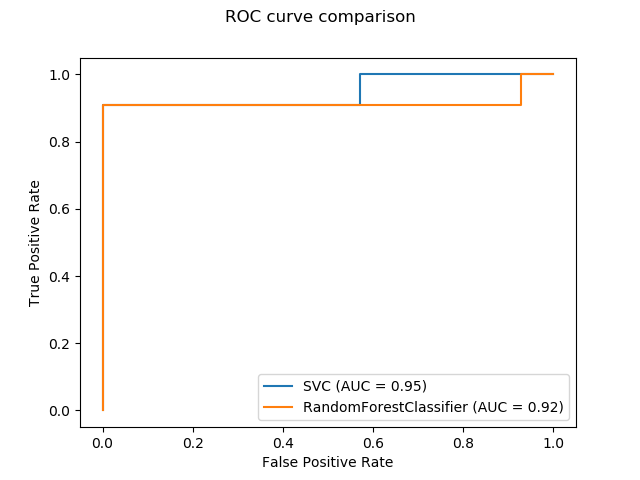sklearn.ensemble.StackingClassifier?
class sklearn.ensemble.StackingClassifier(estimators, final_estimator=None, *, cv=None, stack_method='auto', n_jobs=None, passthrough=False, verbose=0)
帶有最終分類器的估計器堆棧。
堆疊泛化包括堆疊個別估計器的輸出,并使用分類器來計算最終的預測。疊加允許使用每個估計器的強度,使用它們的輸出作為最終估計器的輸入。
注意,estimators_是在完整的X上擬合而來的,而final_estimator_是通過使用cross_val_predict對基礎估計器進行交叉驗證的預測來進行訓練的。
0.22版本新功能。
在用戶指南中閱讀更多內容。
| 參數 | 說明 |
|---|---|
| estimators | list of (str, estimator) 將被堆疊在一起的基礎估計器。列表中的每個元素都被定義為一個字符串元組(即名稱)和一個 estimator實例。可以使用set_params將評估器設置為“drop”。 |
| final_estimator | estimator, default=None 一個分類器,它將被用來組合基礎估計器。默認的分類器是 LogisticRegression。 |
| cv | int, cross-validation generator or an iterable, default=None 確定 cross_val_predict中用于訓練final_estimator的交叉驗證拆分策略。cv可能的輸入有:- None,使用默認的5折交叉驗證。 - Integer, 用于指定(分層的)K-Fold中的折疊數。 - 用作交叉驗證生成器的對象。 - 一個可迭代的產生的訓練、測試分割。 對于 integer/None,如果估計器是一個分類器,并且y是二進制的或多類的,則使用StratifiedKFold。所有其他情況下,使用K-Fold。參考用戶指南,了解這里可以使用的各種交叉驗證策略。 注意:如果訓練樣本的數量足夠大,那么分割的數量再大也沒有什么好處。事實上,訓練時間會增加。cv不是用于模型評估,而是用于預測。 |
| stack_method | {‘auto’, ‘predict_proba’, ‘decision_function’, ‘predict’}, default=’auto’ 為每個基本估計器調用的方法。它可以是: - 如果是“auto”,它將對每個估計器按相應順序調用“predict_proba”、“decision_function”或“predict”。 - 否則,'predict_proba'、'decision_function'或'predict'中的一個。如果估計器沒有實現該方法,它將產生一個錯誤。 |
| n_jobs | int, default=None 所有并行 estimators fit作業數量。除非在joblib.parallel_backend中,否則None表示是1。-1表示使用所有處理器。參見Glossary了解更多細節。 |
| passthrough | bool, default=False 當為 False時,只使用估計器的預測作為final_estimator的訓練數據。當為真時,final_estimator將在預測和原始訓練數據上進行訓練。 |
| verbose | int, default=0 冗余水平。 |
| 屬性 | 說明 |
|---|---|
| classes_ | ndarray of shape (n_classes,) 類標簽。 |
| estimators_ | list of estimators 估計器參數的元素,已在訓練數據上擬合。如果一個估計器被設置為“drop”,那么它將不會出現在 estimators_中。 |
| named_estimators_ | Bunch屬性來按名稱訪問任何適合的子估計器。 |
| final_estimator_ | estimator 給出估計器的輸出來預測的 estimators_。 |
| stack_method_ | list of str 每個基估計器使用的方法。 |
注意
當每個估計器使用predict_proba時(即大多數時候stack_method='auto',或者stack_method='predict_proba'),在出現二進制分類問題時,每個估計器預測的第一列將被刪除。事實上,這兩個特征將是完全共線的。
參考文獻
Wolpert, David H. “Stacked generalization.” Neural networks 5.2 (1992): 241-259.
實例
>>> from sklearn.datasets import load_iris
>>> from sklearn.ensemble import RandomForestClassifier
>>> from sklearn.svm import LinearSVC
>>> from sklearn.linear_model import LogisticRegression
>>> from sklearn.preprocessing import StandardScaler
>>> from sklearn.pipeline import make_pipeline
>>> from sklearn.ensemble import StackingClassifier
>>> X, y = load_iris(return_X_y=True)
>>> estimators = [
... ('rf', RandomForestClassifier(n_estimators=10, random_state=42)),
... ('svr', make_pipeline(StandardScaler(),
... LinearSVC(random_state=42)))
... ]
>>> clf = StackingClassifier(
... estimators=estimators, final_estimator=LogisticRegression()
... )
>>> from sklearn.model_selection import train_test_split
>>> X_train, X_test, y_train, y_test = train_test_split(
... X, y, stratify=y, random_state=42
... )
>>> clf.fit(X_train, y_train).score(X_test, y_test)
0.9...
方法
| 方法 | 說明 |
|---|---|
decision_function(X) |
使用final_estimator_.decision_function對X中的樣本預測決策函數 |
fit(X[, y, sample_weight]) |
擬合估計器。 |
fit_transform(X[, y, sample_weight]) |
擬合估計器和變換數據集。 |
get_params([deep]) |
從集成中得到估計器的參數。 |
predict(X, **predict_params) |
預測X的目標值。 |
predict_proba(X) |
使用final_estimator_.predict_proba預測X的類概率。 |
score(X, y[, sample_weight]) |
返回給定測試數據和標簽的平均精度。 |
set_params(**params) |
從集成中設置估計器的參數。 |
transform(X) |
返回每個估計器X的類標簽或概率。 |
__init__(estimators, final_estimator=None, *, cv=None, stack_method='auto', n_jobs=None, passthrough=False, verbose=0)
初始化self。有關準確的簽名,請參見help(type(self))。
decision_function(X)
使用final_estimator_.decision_function對X中的樣本預測決策函數。
| 參數 | 說明 |
|---|---|
| X | {array-like, sparse matrix} of shape (n_samples, n_features) 訓練向量,其中n_samples為樣本數量,n_features為特征數量。 |
| 返回值 | 說明 |
|---|---|
| decisions | ndarray of shape (n_samples,), (n_samples, n_classes), or (n_samples, n_classes * (n_classes-1) / 2) 決策函數計算最終的估計器。 |
fit(X, y, sample_weight = None)
擬合估計器。
| 參數 | 說明 |
|---|---|
| X | {array-like, sparse matrix} of shape (n_samples, n_features) 訓練向量,其中n_samples為樣本數量,n_features為特征數量。 |
| y | array-like of shape (n_samples,) 目標值。 |
| sample_weight | array-like of shape (n_samples,), default=None 樣本權重。如果沒有,那么樣本的權重相等。當在每個節點中搜索分割時,將忽略創建具有凈零權值或負權值的子節點的分割。在分類的情況下,如果分割會導致任何一個類在任一子節點中具有負權值,那么分割也將被忽略。 |
| 返回值 | 說明 |
|---|---|
| self | object |
fit_transform(X, y=None, sample_weight=None)
擬合數據,然后轉換它。
使用可選參數fit_params將transformer與X和y匹配,并返回X的轉換版本。
| 參數 | 說明 |
|---|---|
| X | {array-like, sparse matrix} of shape (n_samples, n_features) 訓練向量,其中n_samples為樣本數量,n_features為特征數量。 |
| y | ndarray of shape (n_samples,), default=None 目標值。 |
| **fit_params | dict 其他擬合參數。 |
| 返回值 | 說明 |
|---|---|
| X_new | ndarray array of shape (n_samples, n_features_new) 轉化后的數組。 |
get_params(deep=True)
從集成中得到估計器的參數。
| 參數 | 說明 |
|---|---|
| deep | deep : bool, default = True 將其設置為True將獲得各種分類器以及分類器的參數。 |
property n_features_in_
fit 過程中可見的特征數量。
predict(X, **predict_params)
預測X的目標值。
該方法適用于簡單估計器和嵌套對象(如pipline)。后者具有形式為<component>_<parameter>的參數,這樣就可以更新嵌套對象的每個組件。
| 參數 | 說明 |
|---|---|
| X | {array-like, sparse matrix} of shape (n_samples, n_features) 估計器參數訓練向量,其中n_samples為樣本數量,n_features為特征數量。 |
| **predict_params | dict of str -> obj 由 final_estimator調用的predict的參數。請注意,這可能用于從一些使用return_std或return_cov的估計器返回不確定性。請注意,它只會在最終的估計器中考慮不確定性。 |
| 返回值 | 說明 |
|---|---|
| y_pred | ndarray of shape (n_samples,) or (n_samples, n_output) 預測后的目標值。 |
predict_proba(X)
使用final_estimator_.predict_proba預測X的類概率
| 參數 | 說明 |
|---|---|
| X | {array-like, sparse matrix} of shape (n_samples, n_features) 訓練向量,其中n_samples為樣本數量,n_features為特征數量。 |
| 返回值 | 說明 |
|---|---|
| probabilities | ndarray of shape (n_samples, n_classes) or list of ndarray of shape (n_output,) 輸入樣本的類概率。 |
score(X, y, sample_weight=None)
返回給定測試數據和標簽的平均精度。
在多標簽分類中,這是子集精度,這是一個苛刻的指標,因為你需要對每個樣本正確預測每個標簽集。
| 參數 | 說明 |
|---|---|
| X | array-like of shape (n_samples, n_features) 測試樣本。 |
| y | array-like of shape (n_samples,) or (n_samples, n_outputs)X的正確標簽 |
| sample_weight | array-like of shape (n_samples,), default=None 樣本權重。 |
| 返回值 | 說明 |
|---|---|
| score | float self.predict(X) 關于y的平均準確率。 |
set_params(**params)
從集成中設置估計器的參數。
有效的參數鍵可以用get_params()列出。
| 參數 | 說明 |
|---|---|
| **params | keyword arguments 使用例如 set_params(parameter_name=new_value)的特定參數。此外,為了設置堆料估算器的參數,還可以設置疊加估算器的單個估算器,或者通過將它們設置為“drop”來刪除它們。 |
transform(X)
返回每個估計量X的類標簽或概率。
| 參數 | 說明 |
|---|---|
| X | {array-like, sparse matrix} of shape (n_samples, n_features) 訓練向量,其中 n_samples為樣本數量,n_features為特征數量。 |
| 返回值 | 說明 |
|---|---|
| y_preds | ndarray of shape (n_samples, n_estimators) or (n_samples, n_classes * n_estimators) 每個估計器的預測輸出。 |

